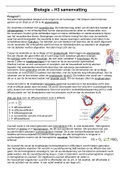Summary
ENGLISH! Samenvatting Thema 2 Blok 4.2. Personality Disorders
- Course
- Institution
- Book
Dit is een uitgebreide Engelse samenvatting van de stof van thema 2, blok 4.2. Personality Disorders. Deze samenvatting is geschikt voor masterstudenten Klinische Psychologie aan de Erasmus Universiteit Rotterdam, jaar 2019/2020. Nogmaals, de samenvatting is vrij uitgebreid, dit vind ik zelf nameli...
[Show more]










